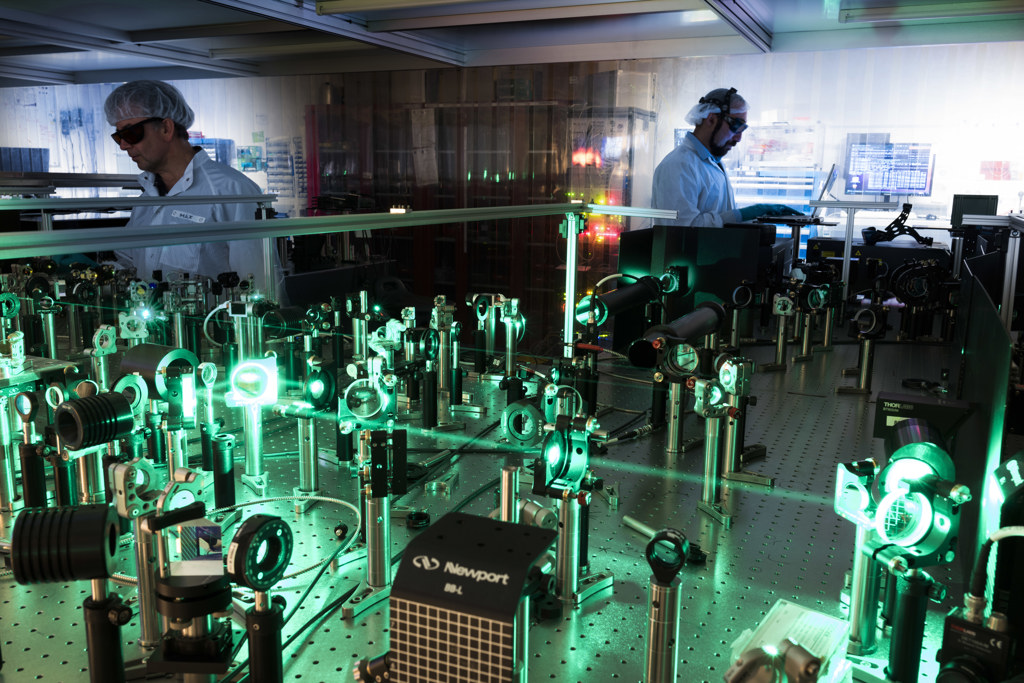About
12 December 2016
Versatile Optical Laser will Enable Innovative Experiments at Atomic-Scale Measurements
12 December 2016
Versatile Optical Laser will Enable Innovative Experiments at Atomic-Scale Measurements
German research team has developed a versatile optical laser for synchronous operation at each of the six XFEL research stations
WASHINGTON — The European X-ray Free-Electron Laser (XFEL) facility, near Hamburg, Germany, was built with one objective — to provide pulses of light short enough, bright enough, and of small enough wavelength to observe processes that would otherwise be too fast and/or too infrequent to measure in real-time.
Without such ultrashort pulses — and this means millionths of billionths of a second long (femtoseconds) — measurements are limited to a before-and-after look at molecular interactions. Six different end-stations will be available for scientists from across the globe to conduct experiments using the XFEL beam once it is fully functioning in 2017.
In order to make these measurements, the research team developed a high-power, pulsed, optical laser that is synchronized with the XFEL pulses and tunable in both wavelength and pulse duration to accommodate the needs of each of the six different experiments being conducted. The features of this versatile optical laser system will be published in a paper in the journal Optics Express, from The Optical Society (OSA).
 |
| Near field profiles of the NOPA pump beams (515 nm). (a) NOPA I, (b) NOPA II, (c) NOPA III. The given dimensions are 1/e2 diameters from Gaussian intensity fits. Ellipticity and Gaussian intensity fit values are >90% in all cases. The images were taken with an exposure time of 80 µs near the center of a single burst. Image Credit: European X-Ray Free-Electron Laser-Facility GmbH (XFEL) |
“The real uniqueness of our laser lies in the fact that it matches the burst emission pattern of the European XFEL,” said Max J. Lederer, lead scientist, XFEL. “It therefore enables experiments at the highest possible pulse rate of the XFEL with optical pulse parameters (energy, pulse duration) only obtainable at low repetition rates from Ti:Sapphire systems.”
These days, finding an optical laser capable of producing ultrashort pulses for research, such as a titanium-sapphire (Ti:Sapph) laser, isn’t difficult. But finding such a laser that can match the power and timing specifications of the six XFEL experiments is difficult. “In other words, it’s the high repetition rate and average power during the bursts that make the difference,” Lederer said.
But why would a facility built to house one of the largest and most advanced lasers, need another laser? In fact, this additional laser system is an integral part of performing the projected atomic-scale measurements. The optical laser pulses serve to prepare samples, using the interaction with it as the first step, in some sense as a control, before using the x-ray pulse to probe and investigate the unknown dynamics. It is mainly the “pump” part of the pump-probe experiments the laser is designed to perform.
“The laser system is [built] to satisfy the need for an experimental optical pump-probe laser, synchronized and adapted to the emission pattern of the European XFEL. The laser will typically activate samples, followed by probing with the X-ray pulses,” Lederer said.
The need for tunability of the pump laser comes from each of the six scientific stations housing different experiments that investigate various sample types and phases of matter. The optical laser provides this configurability via a number of optical techniques that harness light-matter interactions to result in the precise energy and timing of the pulses needed.
One example of such a process is called parametric conversion which refers to the conversion of one particle of light into two of half the energy, or vice versa. “For enhanced experimental flexibility, the spectral range from UV to THz will be made available through parametric conversion and THz-generation schemes,” Lederer said.
Installation of the first laser has already begun and Lederer and his team look ahead to the exciting capabilities of the facility. Lederer said, “We are of course keen to meet the deadline to deliver the ‘first photon’ together with the XFEL. Personally, I’m keen on seeing the laser utilized in as many scientific discoveries as possible in the future.”
PAPER: M. Pergament, G. Palmer, M. Kellert, K. Kruse, J. Wang, L. Wissmann, U. Wegner, M. Emons, D. Kane, G. Priebe, S. Venkatesan, T. Jezynski, F. Pallas, and M. J. Lederer, “Versatile optical laser system for experiments at the European X-ray free-electron laser facility,” Opt. Express 24, 29349-29359 (2016).
DOI: 10.1364/OE.24.029349
About Optics Express
Optics Express reports on new developments in all fields of optical science and technology every two weeks. The journal provides rapid publication of original, peer-reviewed papers. It is published by The Optical Society and edited by Andrew M. Weiner of Purdue University. Optics Express is an open-access journal and is available at no cost to readers online at: OSA Publishing.
About The Optical Society
Founded in 1916, The Optical Society (OSA) is the leading professional organization for scientists, engineers, students and entrepreneurs who fuel discoveries, shape real-life applications and accelerate achievements in the science of light. Through world-renowned publications, meetings and membership initiatives, OSA provides quality research, inspired interactions and dedicated resources for its extensive global network of optics and photonics experts. For more information, visit osa.org/100.
Media Contacts:
mediarelations@osa.org.
